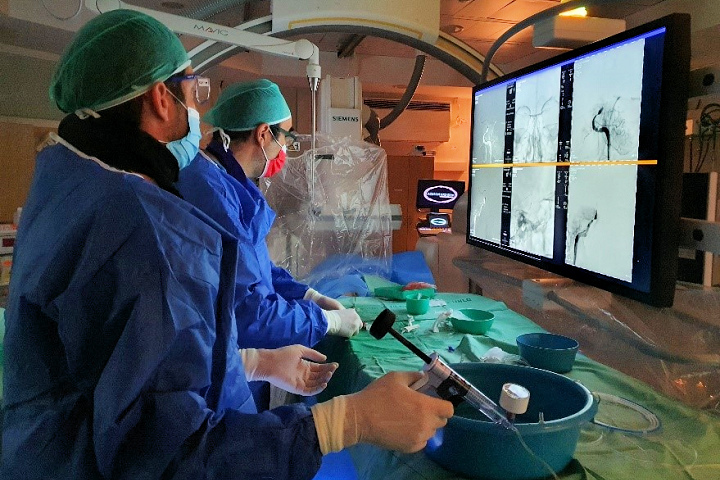A healthy, 32-year-old high-tech engineer suddenly experienced loss of sensation and control on the right side of his body, and difficulty speaking. Understanding these were stroke warning signs, he rushed to Rambam Health Care Campus (Rambam) in Haifa, Israel. By the time he arrived, the symptoms had disappeared. Taking no chances, the medical team was determined to find the cause.
 Dr. Eytan Abergel performing a brain catheterization. Photography: Rambam HCC.
Dr. Eytan Abergel performing a brain catheterization. Photography: Rambam HCC.
Recently, Shimon*, a 32-year-old high-tech engineer was discharged from Rambam’s Department of Neurology B after a rare stroke. A healthy and active individual with no history of smoking or drinking, he had experienced a sudden onset of classic warning signs of a stroke: loss of sensation and control on the right side of his body and difficulty speaking. He immediately went to the hospital’s Green-Wagner Department of Emergency Medicine, but by the time he arrived his symptoms had disappeared.
Advanced imaging tests revealed a tear in the carotid artery in Shimon’s neck. The doctors admitted him for treatment with blood thinners. “When there’s a small tear in the carotid artery, the body can sometimes dissolve the blood clot causing the stroke symptoms and even heal the tear on its own,” explains Dr. Eytan Abergel, director of the hospital’s Invasive Neuroradiology Unit (Brain Catheterization). “That’s why we administer blood thinners and allow the body to do its job.”
However, just a few hours later, Shimon’s symptoms suddenly reappeared, including paralysis on one side of his body, loss of vision, and speech impairment. The team immediately performed an emergency brain catheterization. Interventional radiologists accessed the carotid artery, removed the clot, inserted a stent, and restored normal blood flow to his brain. Shimon was soon surrounded by his family, speaking and laughing and has now been discharged home.
“Shimon’s successful recovery from this rare stroke is a shining example for our department,” shares Inessa Shitik, head nurse at Rambam’s Department of Neurology B. “He was fully capable at discharge—communicating and moving his arms and legs like anyone else. You’d never suspect he had endured such a severe stroke. His remarkable recovery highlights the value of timely, well-coordinated care by a dedicated team.”
“As interventional radiologists, it isn’t common for us to treat stroke cases caused by a carotid artery tear,” adds Abergel. “Most patients respond well to medication, and we typically only need to intervene in such cases about once a year. However, injuries to the carotid artery are not rare. They can occur spontaneously during strenuous physical activity, sudden movements, or even something as simple as a strong sneeze. There have even been cases linked to aggressive neck massages.”
The key takeaway is this: if someone experiences numbness or weakness on one side of their body, or sudden difficulty speaking, they should immediately go to a hospital emergency room.
*Name changed to protect the patient’s identity.

